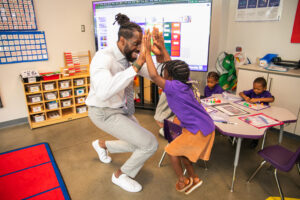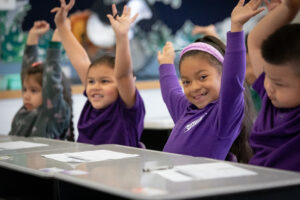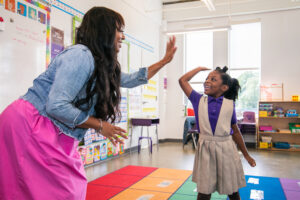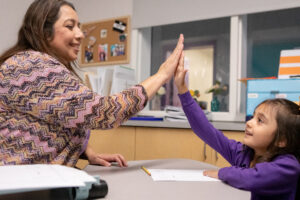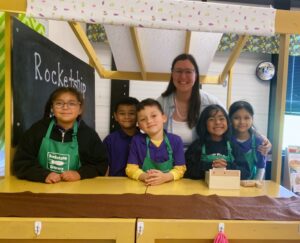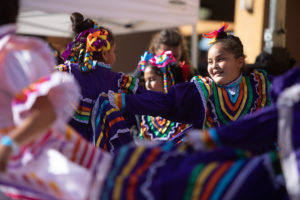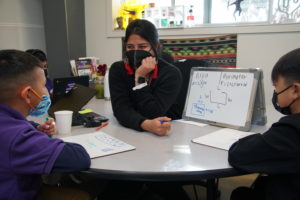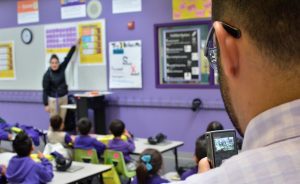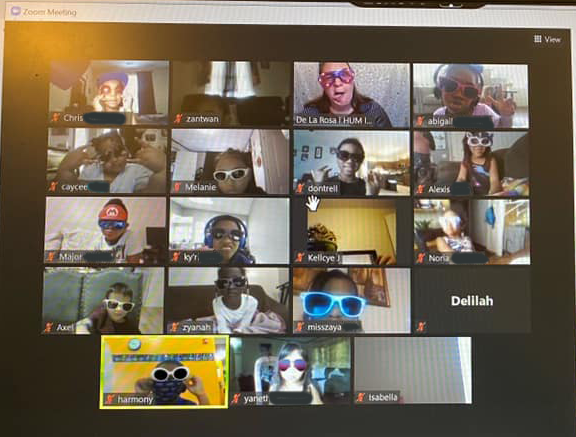
3 Ways to Build Peer-to-Peer Relationships in Virtual Classrooms
James Cross, 4th Grade Teacher, Rocketship Nashville Northeast Elementary
Let’s name the elephant in the room of virtual learning- it’s really hard for our students to establish and maintain peer relationships from behind a computer.
Allotting time for students to be social with their peers is integral to their development. Students will naturally find time during the school day to make friends and it’s important. Social interactions teach kids how to cooperate, share, and be a member of a team. Our foundations of how to read and use social cues stem from peer interactions. But how can this work when kids are miles apart from each other? I’m glad you asked!
Virtual learning calls for us to be strategic and focused on fostering student relationship building. As teachers, we have to plan for opportunities to let our students engage with each other.
Here are three parts of the day that we found to be ideal relationship-building times.
Community Meeting Chats
Nearly every elementary school classroom across the country participates in some form of morning meeting. At Rocketship, we start the day prioritizing social emotional learning, previewing what’s in store, and making sure everyone is ready to learn. Good news, this is also the best time to let your students ground their day in relationship building. Students naturally want to talk to each other and feel more comfortable in class when they know each other.
So, turn the chatbox on in the morning. Let students share out how they are feeling and what they are looking forward to. Let them respond to each other and ask questions. This is the time to let them own the conversation. Feel free to ask questions and jump in, but focus on how you can help facilitate students talking to students. I’ll be honest, this will take some time. Students need to build their confidence and the more opportunities they have, the more comfortable they will be.
Now that your students are taking full advantage of chat time, take things to the next level. Open breakout rooms and let them have an actual private space to talk. Make randomized breakout rooms of two to three students.
We like to ground their conversation in how they are feeling, what they did after school the day before, and what they are looking forward to, but let’s not limit their talk time. Sometimes this becomes a game of roulette because we will mix up the groups and let them talk to multiple partners.
I guarantee you that your students will love getting to have some unstructured talk time to check-in with each other and energize their morning.
Bonus Points: If you really want to push yourself with engaging your students in peer to peer relationships, utilize their break times. We have a natural compulsion to want to fill this time with something like music or quiet time. Instead, let them have the chance to engage with each other. Open the chat and let them share.
Let your kids come off mute and say hi to each other. This might not seem like a lot of time, but every down minute is an opportunity for students to grow their friendships.
Show-Call Student Work
I will never forget being in fourth grade and Mr. White would always circle the room. He would give us feedback, but we knew he was always mentally selecting someone’s work. By the end of our work time, he would have placed multiple examples of our work under the doc cam. We never felt prouder than when our work made it to the Smart Board. This is still a high leverage move that great teachers use. And, it is even easier to use in a virtual setting.
As students complete their work, check it over.
Find work that shows evidence of student mastery. Take a screenshot and black the students’ names out. Find some student work that isn’t quite there yet, but just needs a little feedback. Again, blackout the student’s name and show it to the class. Have the students analyze the work samples. What are the students doing well? Do they agree or disagree with their peer’s work? How can they push their peers to do even better? This is an old staple of teaching, but it works!
Show-calling student work brings your students together. They have a space to compare their own work to their peers. Students have the opportunity to feel seen by their classmates. This strategy will help your students build confidence and get used to talking about their learning with their classmates. Have a conversation beforehand about how to stay positive, constructive, and accountable.
Fun Friday Festivities
Fun times are always going to be the best time for students to build rapport with each other. We call this one Fun Friday Festivities, but this doesn’t have to be reserved for Friday only. In fact, I would say you could do something creative to end every school day! All you have to do is reserve some time at the end of class for a special activity.
One of my favorite activities is Zoom show and tell. Give students one minute to go and find something they would like to share with the class. It could be a toy, something in their room, or even their favorite pet. I’ve had students take me on a tour of their backyard or to the room dedicated to their pet bunnies. Their home is their oyster.
Once, they find what they want to show, give them each an opportunity to share it with the class. This will help students want to participate in class and feel more comfortable because they can find connections with each other.
Another great activity is a scavenger hunt. Your students take turns picking what the other kids need to go find somewhere in their house to bring back. They could search for something green or something that fits in a small space. The scavenger hunt opportunities are endless. This activity gives your students the chance to share their home with each other, while giving them time to talk and socialize with each other.
At the end of the day, we can’t expect our students to establish and build peer relationships if we don’t actually give them the time to build them. Have fun with this and let the kids talk!
Published on November 1, 2020
Read more stories about: Tips for Engagement.
In the Classroom
How to Foster a Growth Mindset in the Classroom
| April 10, 2025
Learn how to cultivate reflection, embrace challenges, and promote perseverance in yourself and in your students.
Read more ⟩How to Improve School Culture
Jeremiah Davis, Paraprofessional, Rocketship Dream Community Prep | March 3, 2025
Ready to ramp up moral at your school? Weave these nine celebrations into your school year!
Read more ⟩How Coaching in Schools Improves Outcomes
Rockesthip Public Schools | Feb 4, 2025
Learn how live coaching and weekly feedback sessions can help your teachers feel more supported year round!
Read more ⟩Parent Conference Tips for First Year Teachers
Jeremiah Davis, Paraprofessional, Rocketship Dream Community Prep | January 6, 2025
Looking for top parent conference tips? Prepare with advice from our educators.
Read more ⟩First Year Teacher? Here are Five Mistakes to Avoid.
Jeremiah Davis, Paraprofessional, Rocketship Dream Community Prep | November 1, 2024
See what mistakes most first year teachers make and how you can get ahead this school year with some simple tips from a fellow educator.
Read more ⟩3 Classroom Systems New Teachers Swear By
Rocketship Public Schools | Sept. 30, 2024
As a first year teacher, establishing a smooth and productive classroom environment can feel a tad overwhelming. Thankfully, these simple strategies can go a long way.
Read more ⟩How Co-Teacher Collaboration Can Benefit Your Classroom
Featuring Alejandra Chavez, Education Specialist at Rocketship Mosaic Elementary | June 10, 2024
Hear from Ms. Aly about how a small team of educators can make a big difference in student outcomes through thoughtful planning, focused collaboration, and personalized accommodations. Ms. Aly was one of our highest-performing educators in California for the 23-24 school year.
Read more ⟩How to Spark Joy in ESL Classrooms with a Multilingual Learning Clubhouse
Featuring Ms. Amy De La Rosa, Multilingual Specialist, Nashville Northeast Elementary | June 1, 2023
Listen in to an audio interview with Amy De La Rosa, a Multilingual Specialist who has worked as an educator for over 14 years and found an innovative way to help her students learn English in a more accelerated, playful way.
Read more ⟩Supporting Parents of Multilingual Students in Family/Teacher Conferences
Emma Volpe, Rocketship United Academy | June 1, 2022
Get thoughtful insight on how to create a more inclusive family-teacher conference environment.
Read more ⟩5 Ways to Strengthen Relationships in the Classroom
James Cross, Assistant Principal, Rocketship Nashville Northeast Elementary | February 20, 2022
A new age of education calls for a new level of connection. Here are some key tips to strengthen relationships in your classroom this school year.
Read more ⟩5 Ways School Leaders Can Coach and Support Teachers
Eesir Kaur, Director of Professional Development | October 15, 2020
Are you a school leader looking to coach your teachers more effectively? Here's what works for us.
Read more ⟩



